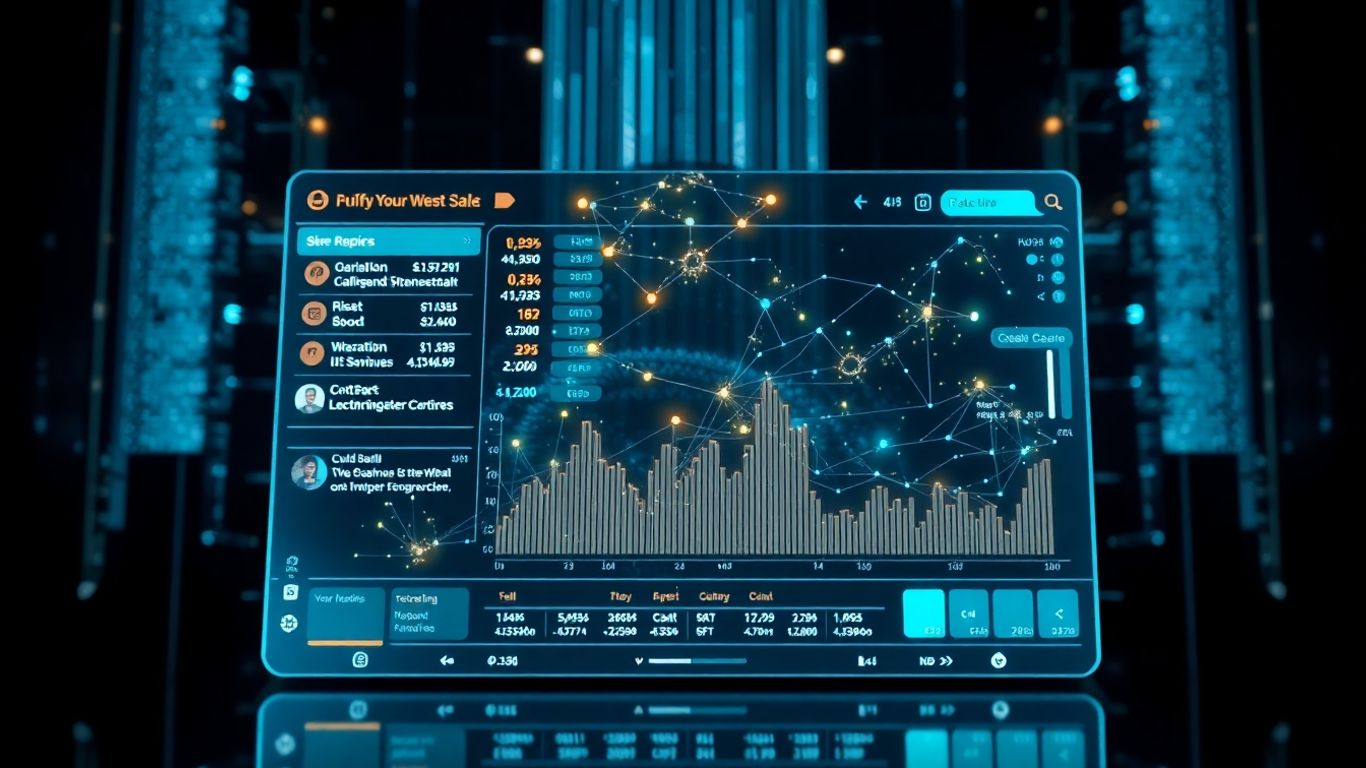[ newsletter ]
Stay ahead of Web3 threats—subscribe to our newsletter for the latest in blockchain security insights and updates.
Thank you! Your submission has been received!
Oops! Something went wrong. Please try again.
Explore transaction graph analysis Web3: visualize fund flows, detect illicit activities, and enhance security with advanced techniques. Learn key principles and implementation.





Trying to make sense of all the transactions happening on the blockchain can feel like looking at a giant, tangled ball of yarn. That's where transaction graph analysis web3 comes in. It's a way to untangle that mess, turning raw data into something we can actually understand. Think of it like a detective using a map to follow clues. This method helps us see where money comes from, where it goes, and who might be involved, which is super important for keeping the crypto world safe and honest.
So, what exactly is transaction graph analysis in the context of Web3? Think of it as a super detailed map of all the money moving around on a blockchain. Instead of just seeing a list of transactions, we're looking at the connections. Every wallet address is like a point on the map, and every time crypto moves from one wallet to another, it's a line connecting those points. This visual approach helps us see the bigger picture of how funds flow and who's interacting with whom. It's a way to untangle the complex web of digital asset movements that happen every second.
Imagine a detective trying to figure out where stolen money went. They wouldn't just look at one bank account; they'd trace every single transfer, looking for patterns and hidden links. Transaction graph analysis does the same thing, but for crypto. It's like having a magnifying glass over the entire blockchain, letting us follow the money trail, identify suspicious clusters of wallets, and understand how funds are being moved, even if people try to hide it. It's financial forensics, but for the digital age.
To really get this, let's break down what goes into it:
Here's a quick look at how the data is structured:
This method transforms raw, often overwhelming, transaction data into a structured, visual format that makes complex financial relationships understandable. It's the foundation for uncovering hidden activities and understanding the true movement of value on the blockchain.
Transaction graph analysis takes the raw, often overwhelming, data from a blockchain and turns it into something understandable. Think of it like taking a massive, messy pile of receipts and organizing them into a clear financial statement. The whole point is to make sense of how money, or in this case, crypto, actually moves around.
At its heart, transaction graph analysis is about seeing the connections. Every crypto address is a point, and every transaction is a line connecting those points. This creates a visual map of where funds originate, where they go, and who they interact with. It's not just about seeing a single transaction; it's about tracing a whole path, like following a river from its source to the sea. This visual approach helps spot patterns that would be impossible to see in raw data. For instance, you can see if a lot of small transactions are all funneling into one big wallet, or if funds are being spread out across many different addresses. This is super helpful for understanding the overall financial ecosystem on the blockchain. It’s a way to get a clearer picture of the Web3 presents both opportunities and challenges for data analysts.
Once you can see the flows, you start noticing recurring patterns. Are certain addresses always interacting? Do some wallets seem to act as central hubs, receiving from many and sending to many others? Graph analysis uses algorithms to find these structures. It can group addresses that likely belong to the same person or entity, even if they use multiple wallets. This is called address clustering. It also helps identify unusual activity, like a sudden surge of transactions to or from a known risky address. These patterns can reveal coordinated activity, potential money laundering schemes, or even the movement of funds from a hack. It's like a detective looking for clues in a vast network of interactions.
The real magic here comes from the fact that most blockchains are public. Every transaction is recorded and can be seen by anyone. This transparency is what makes graph analysis possible. Unlike traditional finance, where many transactions happen behind closed doors, on-chain data is out in the open. This allows analysts to build these detailed maps and uncover hidden relationships. It’s this open nature that allows for forensic investigations and compliance checks that were previously very difficult to perform. The immutability of the ledger also means that once a transaction is recorded, it stays there, providing a reliable history to analyze.
Here's a quick look at what we're trying to achieve:

Getting the raw data from the blockchain is the first step. Think of it like gathering all the transaction receipts from a busy marketplace. We need to pull transaction details – who sent what, to whom, when, and how much. This data usually comes from running a full node on the blockchain, using public explorers, or subscribing to specialized data services. Once we have this mountain of transaction data, we start building the graph. In this graph, each cryptocurrency wallet address becomes a 'node,' and every transaction between two addresses is an 'edge' connecting them. These edges can be directed, showing the flow of funds, and often have attributes like the transaction amount or the time it happened. We can use special graph databases, like Neo4j or TigerGraph, or libraries in programming languages like Python to build and manage these complex networks.
Blockchains are pseudonymous, meaning addresses don't directly link to real-world identities. This is where address clustering comes in. We use smart detective work, called heuristics, to group addresses that likely belong to the same person or organization. For example, if multiple addresses are used as inputs for a single transaction, they probably belong to the same owner. We also look at patterns, like how funds move in and out of known exchange wallets. These techniques help us piece together a clearer picture of who controls which wallets, even if they use many different ones.
With the graph built and addresses clustered, we can start looking for interesting things. This involves using algorithms to find specific paths funds have taken, identify the most influential addresses (the 'hubs' of activity), or detect groups of addresses that interact a lot. We're also on the lookout for anything unusual – transactions to or from known illicit addresses, activity that looks like money laundering (like using mixers or rapid coin swaps), or just really strange transaction volumes or timings. Spotting these anomalies is key to uncovering suspicious activity.
The transparency of blockchains means every transaction is recorded. The challenge isn't getting the data, but making sense of the sheer volume and complexity. Graph analysis turns that raw data into understandable connections and flows, revealing patterns that would otherwise stay hidden.
Web3's transparent ledger is a double-edged sword. While it offers incredible visibility, it also presents unique challenges for security and compliance. Transaction graph analysis becomes a vital tool here, helping us make sense of the complex flows of digital assets and identify potentially risky activities. It's like being a digital detective, piecing together clues on the blockchain.
One of the most direct applications of transaction graph analysis is tracking down funds that have been involved in illegal activities. When a hack or scam occurs, the stolen assets don't just disappear. They move. By mapping out these movements, we can follow the trail of funds, even across different blockchains or through various wallets. This helps law enforcement and security teams identify the perpetrators and potentially recover stolen assets. It's not always straightforward, though, as criminals often try to obscure their tracks using techniques like mixing services or rapid transfers.
The ability to visualize and analyze these complex transaction paths is what makes graph analysis so powerful for uncovering illicit activities that might otherwise remain hidden.
Money laundering in Web3 often involves 'layering,' where criminals try to distance illicit funds from their source through a series of complex transactions. Transaction graphs are perfect for spotting these layering schemes. We can see how funds are broken down, sent through numerous intermediary wallets, and then consolidated again. This helps financial institutions and compliance officers identify suspicious activity that might indicate money laundering operations.
Terrorist organizations, like other criminal groups, can use cryptocurrencies to fund their operations. Transaction graph analysis can help identify these networks by mapping out financial flows that might be linked to known terrorist entities or suspicious organizations. By analyzing the connections and transaction volumes, authorities can gain insights into how these groups are acquiring and moving funds, which is critical for disrupting their activities.

So, you've got your transaction graph all built out, and you're starting to see some interesting patterns. That's great! But to really get the most out of it, we need to go a bit deeper. This is where advanced techniques and data enrichment come into play. It's like taking your basic map and adding layers of detail – weather patterns, traffic, points of interest – to make it truly useful.
On-chain data is fantastic, but it's only half the story, right? Think about it: a wallet address itself doesn't tell you much. Is it a regular user, a known exchange, or maybe a scammer's hot wallet? That's where off-chain intelligence comes in. We can link those blockchain addresses to real-world entities or known risk profiles. This could involve using data from services that label addresses associated with illicit activities, darknet markets, or even sanctioned individuals. It's about connecting the dots between the digital ledger and the physical world.
Building on the idea of off-chain intelligence, we can create sophisticated risk networks. Imagine a web where nodes are addresses and edges represent transactions, but now these nodes are colored or tagged based on their risk level. This allows us to see not just how funds move, but how risky those movements are. For instance, if funds flow from a high-risk address through several intermediaries before landing in a seemingly legitimate one, that's a red flag. This kind of analysis is key for Web3 Analytics and compliance.
The effectiveness of transaction graph analysis is significantly amplified when combined with external data sources. This fusion transforms raw on-chain activity into actionable intelligence, revealing the true nature of financial flows and participant behaviors.
Now, let's talk about the cutting edge. Artificial intelligence is really starting to make waves here. AI models can sift through massive datasets, identify complex patterns that humans might miss, and even predict future behavior. For example, AI can be used to develop "trust scores" for wallets or smart contracts. These scores aren't just based on a single metric; they can incorporate transaction history, code analysis, and known vulnerabilities. Think of Veritas Protocol's approach, using multi-agent AI systems to analyze entire ecosystems and generate these scores, providing a more nuanced view of security and trustworthiness. This is a big step up from just looking at transaction counts.
By layering these advanced techniques, we move from simply observing transactions to truly understanding the relationships, risks, and trustworthiness within the Web3 ecosystem.
Alright, so diving into Web3 analytics, especially when you're trying to map out transaction flows, isn't always a walk in the park. There are definitely some hurdles we need to talk about. It's not like traditional finance where you have clear identities and regulations. Here, things are a bit more... fluid.
One of the biggest head-scratchers is the whole pseudonymity thing. People use different wallets for different things, or maybe they just have a bunch of them. This makes it tough to figure out if you're looking at one person with multiple addresses or multiple people using the same wallet. It's like trying to track someone who keeps changing their disguise.
The core issue is linking on-chain activity to real-world identities, which is inherently difficult with pseudonymous systems.
This lack of direct identification means that while we can see the money moving, pinpointing the exact individual or organization behind it requires a lot of detective work and educated assumptions. It’s a constant game of connecting the dots.
Then there's the whole multi-chain universe. Users aren't just hanging out on Ethereum anymore. They're hopping between Polygon, Solana, Arbitrum, and who knows where else. Tracking a user's journey across these different blockchains is like trying to follow a river that splits into a dozen streams.
Finally, the Web3 world moves at lightning speed. Exploits happen, trends spike, and opportunities appear and disappear in minutes. Waiting hours for data to process just doesn't cut it anymore. We need information as it happens.
It's a complex puzzle, but by tackling these challenges head-on, we can build more robust and insightful transaction graph analysis for the entire Web3 ecosystem.
So, we've looked at how transaction graph analysis can really help us see what's going on with crypto movements. It's like having a map that shows where money is going, who's moving it, and if it looks a bit shady. Whether it's for figuring out money laundering schemes or just understanding how users interact with dApps, this kind of analysis gives us a clearer picture. It's not magic, and there are still challenges, especially with privacy coins and complex DeFi moves, but the tools are getting better. Being able to visualize these flows is a big step forward for security and transparency in the Web3 world.
Imagine looking at a big map of all the money moving around in the crypto world. Transaction graph analysis is like using a special magnifying glass to see exactly how money travels from one digital wallet to another. It turns all the complicated transaction records into a picture, like a network of roads, showing where money comes from, where it goes, and who's involved. This helps us understand the flow and find out if something fishy is going on.
Web3, like cryptocurrencies, is built on public records that everyone can see. Transaction graph analysis uses this openness. It helps us spot patterns, like if someone is trying to hide where their money came from by moving it around a lot. It's also super helpful for keeping things safe and legal, like stopping criminals from using crypto for bad things.
First, we collect all the transaction data from the blockchain, which is like gathering all the traffic reports. Then, we turn each crypto wallet into a dot (called a node) and each money transfer into a line connecting those dots (called an edge). We use special computer programs to organize this information and then look for interesting connections or suspicious routes, almost like a detective piecing together clues.
Yes, it definitely can! By following the money trail, we can track down funds that were stolen in hacks or used for illegal activities. It helps law enforcement and security teams see where the money ends up, even if criminals try to mix it up or move it across different crypto networks. It's like having a GPS for dirty money.
One big challenge is that people can use many different digital wallets, making it hard to know if it's one person or many. Also, money can move between different crypto networks (like from Ethereum to another one), making it tricky to follow the whole journey. Plus, all this data is happening super fast, so we need quick tools to keep up and understand what's happening in real-time.
By understanding how money moves, we can build better defenses. It helps us identify risky wallets or suspicious activities early on. This means we can work to prevent scams, money laundering, and other illegal uses of crypto, making the whole Web3 space more trustworthy and secure for everyone.


